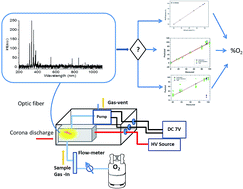Corona discharge induced plasma spectroscopy (CDIPS) for quantitative analysis of gas mixtures
Abstract
The capability of the Corona Discharge Induced Plasma Spectroscopy (CDIPS) technique has been demonstrated for quantitative analysis of nitrogen–oxygen mixtures. Optical emission of the induced plasma in combination with multivariate chemometric methods of calibration such as Partial Least Squares (PLS) regression and Neural Networks (NNs) was able to produce a highly dynamic calibration curve (from 0% to 100% of O2/N2 mixtures) with a high sensitivity, for the measurement of medical grade O2 and N2. The predictive ability of NNs, supported by nonlinear data modelling, can be useful in the quantitative analysis, overcoming experimental effects and producing a smaller relative error in comparison to PLS. For validation purposes, all samples were also analyzed by gas chromatography showing an excellent agreement in the O2/N2 compositions measured within the limit of relative error. The methodology presented shows high potential as an alternative method for the monitoring and analysis of oxygen and nitrogen mixtures in production systems, especially for medical applications.



 Please wait while we load your content...
Please wait while we load your content...